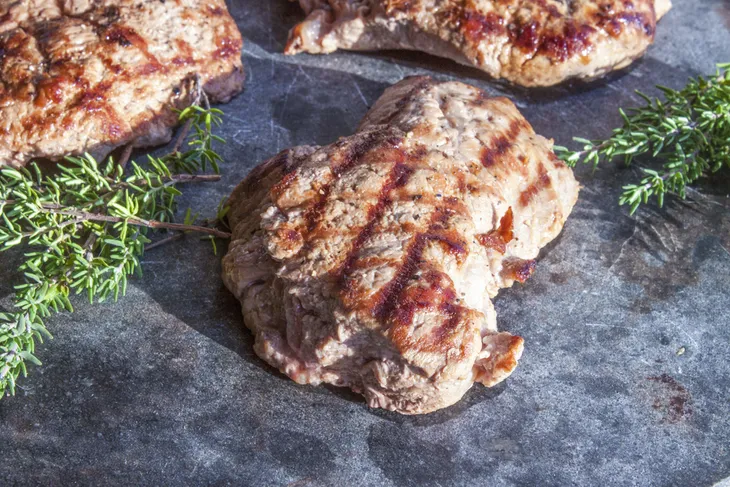When it comes to grilling, everyone has their go-to grub. Whether it’s juicy burgers, BBQ chicken, or spicy sausages, these flame-broiled classics dominate summertime menus because they taste great, are easy to cook, and fill the air with the seasonal aroma you dream about all winter long.
Maintaining your health, on the other hand, tends not to come to mind when igniting that pile of charcoal in your trusty Weber grill. It doesn’t have to be this way though. There are plenty of grilling options out there that are better for you—and arguably better tasting—than the old summer standbys.
Bison
Bison is a great place to start when it comes to alternative meats. It can easily replace either ground beef for burgers or choice cuts for steaks without losing the singular taste of red meat. Also, while most people would be hard pressed to even notice a difference between the two meats, some red meat coinsures swear that bison has a fuller, richer taste than ordinary beef.
And here is the best part about bison…it’s WAY healthier than beef. Not only is it significantly lower in saturated fat and cholesterol due to its leaner nature, it’s also packed with all sorts of nutrients that just aren’t in beef like zinc, niacin, vitamin B6, and selenium. Finally, when purchasing bison you are essentially sidestepping the industrial food complex. On average, bison is raised, slaughtered, and processed under much better conditions than the typical cow.
Goat
A good way to describe the difference between beef and mutton is to compare cow cheese with goat cheese. You know how goat cheese just seems creamier, richer, and more, well, cheesier? Same can be said of goat meat. Get some ground goat for burger patties, grill them up, and you’ll find a surprisingly richer, gamier take on the burger.
Health wise, goat meat has a third fewer calories than beef and a quarter fewer calories than chicken. Many of the calories missing from goats are fat calories, too. For you tree huggers out there, goats are a more sustainable animal than cow. For every acre that two cows will graze, as many as 10 goats will graze that same amount. Still not convinced? Well the rest of the world is because goat is the most consumed red meat on the face of the earth. Chew on that.
Rabbit
Rabbit is probably the leanest meat you can get your hands on. That does not mean rabbit is lacking in protein, however. This white meat packs more protein per ounce than both chicken and beef. Rabbit is also loaded with phosphorus and potassium, minerals not in abundance in other meats.
Ecologically, rabbits are raised grain free and have an immensely lower environmental impact than pigs, cows, or chickens. They are also easy to breed, clean, and process which leads some to wonder if this protein might be the answer to hunger problems in the developing world. One catch with rabbit meat, since it is so lean and delicate, is that you have to cook it slowly. Forget trying to grind it and then grill as a burger. A slow cooked sausage works well, as does a whole or half rabbit smoked or grilled at a leisurely pace.
Elk
Elk meat is a good grilling option if you are just beginning to explore alternative meats or you are cooking for someone who might be a bit squeamish about trying anything outside the standard flame-broiled menu.
Whether ground up as a burger or cooked as a steak cut, elk is a very comparable meat to beef in taste and texture. It is also not far off from beef nutritionally, with a few important wrinkles. While elk contains a comparable amount of calories, fat, and protein, an average portion of elk meat contains 100 percent of your daily dose of vitamin B-15, along with healthy amounts of riboflavin, zinc, phosphorus, thiamine, selenium, and iron.
Alligator
While hard to find in certain locales, gator meat is worth tracking down. Here is why: alligator contains as much as twice the amount of protein found in beef while also having significantly less fat and basically zero cholesterol. The taste ain’t bad either. Think chicken with a tougher gamier flavor.
Generally, the tail meat is what you will be eating when it comes to alligators. Chefs serve up this reptile’s impressive tail in a number of ways including fillets, sausages, and even ground patties. One note of warning, however…alligator is often found to have high levels of mercury, so it should be consumed in the same manner as high-mercury fish (i.e., in moderate amounts or not at all if you are pregnant).
Alpaca
While primarily harvested for the fiber it produces, the alpaca has long sustained the people of South America since even before the time of the Incas. Often cited as the lowest cholesterol meat out there, this llama-like animal, which South Americans call “La Viande,” also packs a mean protein punch that puts it on par with any other meat you can find.
Alpaca meat is tender and noticeably sweet, which makes it a perfect cornerstone for any recipe that features a sweeter component to it like BBQ burgers or steaks with caramelized onions. The secondary cuts, often turned into hot dogs or sausages, are even easier to pair with a host of your favorite condiments. And don’t get hung up on eating such a cute animal. Eating their meat makes these animals more economically valuable to the farmers who make limited income on Alpaca fur.
Octopus
Just trust me. This one will surprise you. It might be better to try this at a reputable seafood grill before taking a crack at it yourself, but either way, there is nothing tastier than grilled octopus tendrils. Don’t get grossed out. If you like regular old beefsteak, you will like octopus. The similar meatiness mixed with char grilled flavor takes many people by surprise. Instead of savory and tender, though, there is more of a rough chewy texture to it. Think of it as a smoother version of jerky.
Then there’s the health benefits. High in protein, low in fat, a small serving of this porous mollusk will provide you with your daily dose of iron, B-12, and selenium. One note of caution with this creature of the deep…it is quite high in cholesterol, eclipsing even pork in the amount contained within a serving.
Ostrich
Even though this African bird is considered a red meat (often compared to bison) it is very comparable to chicken in nutritional facts. Ostrich, however, serves as a good change up from chicken from time to time because it contains a couple of things that are lacking in chicken, namely Vitamin B-12. While your average portion of chicken only includes about 5-percent of your daily-recommended dose, ostrich has over 100-percent. Ostrich also has slightly more iron and protein than chicken.
Despite being the world’s largest bird, the ostrich does not provide breast meat like chicken, turkey or duck. Instead, the meat comes from the legs, thighs, and back. Most often, that meat gets into steak cuts, ground patties, or sausages. However it is prepared, ostrich is one of the “meatiest” of birds you can sink your teeth into.











